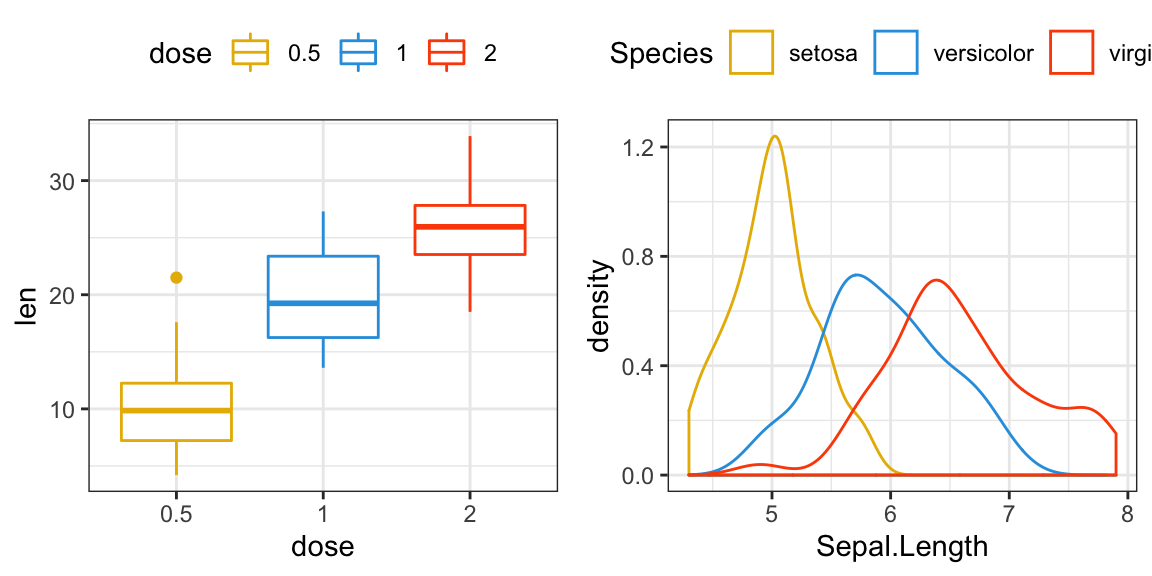In this article, you'll learn to use plot function in R. It is used to make graphs according to the type of the object passed.
Put 2 Plots Together In R

In the simplest case, we can pass in a vector and we will get a scatter plot of magnitude vs index. But generally, we pass in two vectors and a scatter plot of these points are plotted. For example, the command plot(c(1,2),c(3,5)) would plot the points (1,3) and (2,5). Here is a more concrete example where we plot a sine function form range -pi. How can I plot two graphs in same plot in R, I am using this command to perform my task but it isn't working. X 2, 2) plot(x, y1, type = '2', col = 'blue') plot(x, y2, type = 'l', col = 'yellow') Please help me with it. R makes it easy to combine multiple plots into one overall graph, using either the par or layout function. With the par function, you can include the option mfrow=c (nrows, ncols) to create a matrix of nrows x ncols plots that are filled in by row. Mfcol=c (nrows, ncols) fills in the matrix by columns. Mastering R plot – Part 2: Axis. Posted on February 6, 2016 by Lionel Hertzog in R bloggers 0 Comments This article was first published on DataScience+, and kindly contributed to R-bloggers. (You can report issue about the content on this page here). An alluvial chart is a variation of the sankey plot. It visualizes frequency distributions over time or frequency tables involving several categorical variables. In R, 2 packages exist to build an alluvial diagram: alluvial and ggalluvial.
The most used plotting function in R programming is the
plot() function. It is a generic function, meaning, it has many methods which are called according to the type of object passed to plot()
In the simplest case, we can pass in a vector and we will get a scatter plot of magnitude vs index. But generally, we pass in two vectors and a scatter plot of these points are plotted.
For example, the command plot(c(1,2),c(3,5)) would plot the points (1,3) and (2,5).
Here is a more concrete example where we plot a sine function form range -pi to pi.
Adding Titles and Labeling Axes
We can add a title to our plot with the parameter main. Similarly, xlab and ylab can be used to label the x-axis and y-axis respectively.
Changing Color and Plot Type
2 Plots In R
We can see above that the plot is of circular points and black in color. This is the default color.
We can change the plot type with the argument type. It accepts the following strings and has the given effect.
Similarly, we can define the color using col.
Overlaying Plots Using legend() function
Two Plots In R Ggplot
Calling plot() multiple times will have the effect of plotting the current graph on the same window replacing the previous one.
However, sometimes we wish to overlay the plots in order to compare the results.
This is made possible with the functions lines() and points() to add lines and points respectively, to the existing plot.
We have used the function legend() to appropriately display the legend. Visit legend() function to learn more.

In the simplest case, we can pass in a vector and we will get a scatter plot of magnitude vs index. But generally, we pass in two vectors and a scatter plot of these points are plotted. For example, the command plot(c(1,2),c(3,5)) would plot the points (1,3) and (2,5). Here is a more concrete example where we plot a sine function form range -pi. How can I plot two graphs in same plot in R, I am using this command to perform my task but it isn't working. X 2, 2) plot(x, y1, type = '2', col = 'blue') plot(x, y2, type = 'l', col = 'yellow') Please help me with it. R makes it easy to combine multiple plots into one overall graph, using either the par or layout function. With the par function, you can include the option mfrow=c (nrows, ncols) to create a matrix of nrows x ncols plots that are filled in by row. Mfcol=c (nrows, ncols) fills in the matrix by columns. Mastering R plot – Part 2: Axis. Posted on February 6, 2016 by Lionel Hertzog in R bloggers 0 Comments This article was first published on DataScience+, and kindly contributed to R-bloggers. (You can report issue about the content on this page here). An alluvial chart is a variation of the sankey plot. It visualizes frequency distributions over time or frequency tables involving several categorical variables. In R, 2 packages exist to build an alluvial diagram: alluvial and ggalluvial.
The most used plotting function in R programming is the
plot() function. It is a generic function, meaning, it has many methods which are called according to the type of object passed to plot().In the simplest case, we can pass in a vector and we will get a scatter plot of magnitude vs index. But generally, we pass in two vectors and a scatter plot of these points are plotted.
For example, the command plot(c(1,2),c(3,5)) would plot the points (1,3) and (2,5).
Here is a more concrete example where we plot a sine function form range -pi to pi.
Adding Titles and Labeling Axes
We can add a title to our plot with the parameter main. Similarly, xlab and ylab can be used to label the x-axis and y-axis respectively.
Changing Color and Plot Type
2 Plots In R
We can see above that the plot is of circular points and black in color. This is the default color.
We can change the plot type with the argument type. It accepts the following strings and has the given effect.
Similarly, we can define the color using col.
Overlaying Plots Using legend() function
Two Plots In R Ggplot
Calling plot() multiple times will have the effect of plotting the current graph on the same window replacing the previous one.
However, sometimes we wish to overlay the plots in order to compare the results.
This is made possible with the functions lines() and points() to add lines and points respectively, to the existing plot.
We have used the function legend() to appropriately display the legend. Visit legend() function to learn more.
Also visit plot() function to learn more about different arguments plot() function can take, and more examples.
- PREVIOUS
R Strip Chart - NEXT
R Multiple Plots
